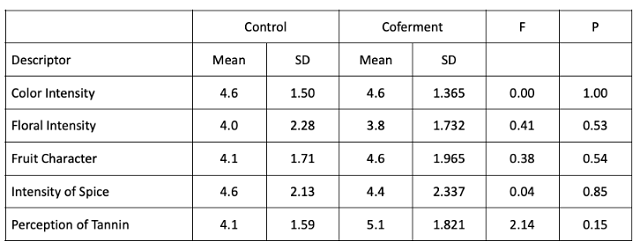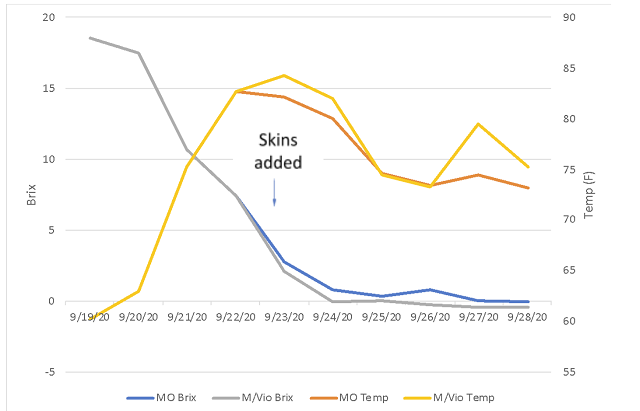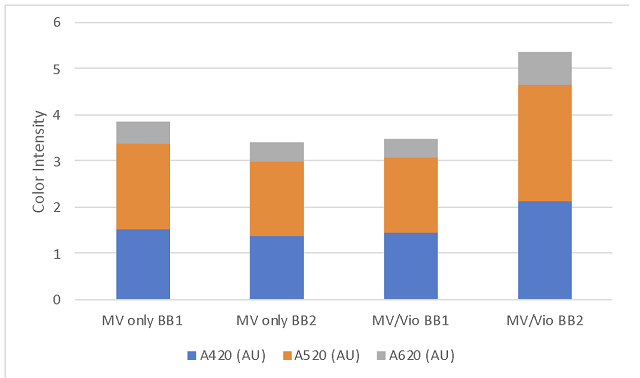Co-fermentation of Mourvèdre and Viognier to achieve a less tannic red wine (2020)
Michael Heny
Michael Shaps Wineworks
Summary
Despite producing full-bodied, meaty wines in its home region, Mourvèdre only enjoys mixed success in Virginia. In this experiment, Mourvèdre was co-fermented with the pressed skins of Viognier with intention to utilize the cofactors potentially found in Viognier to stabilize color and phenolics in Mourvèdre (à lá Southern Rhône). The inclusion of 9% (wt) Viognier skins led to an increase in pH in the finished wine (3.72 vs. 3.85) as well as a potential increase in anthocyanins and tannins. In a triangle test, 16 out of 33 participants were able to tell the difference between the wines, indicating that co-fermented wine was significantly different. When asked how they could tell the difference, respondents noted differences in aromatics (with the Viognier co-ferment having more floral aromatics) as well as lighter body. However, there were no significant differences in descriptive scores between the wines for floral character, fruit character, intensity of spice, or perception of tannin.
Introduction
Mourvèdre (aka Monastrell) likely originated in Saguntao in the Camp de Morvèdre region of Valencia Spain. In its home region, Mourvèdre produces full bodied, meaty wines with aromas of dark fruits and flowers1. Several sources mention its propensity to reduction1,2.
Mourvèdre has several characteristics that lead to mixed success in Virginia. It is cold tender, limiting its range. On the positive side, it buds relatively late, making it less susceptible to spring frost. However, it also ripens late, requiring 180 frost free days, and requires high temperatures at the end of the growing season to reach its full potential. This can lead to problems with late season rains and onset of cooler temperatures. Its late ripening can also tend toward lower phenolic maturity in cooler years. Mourvèdre has large, compact clusters and tends toward high fertility. It does have tough skins that provide good resistance to Botrytis and Phomopsis, however it is susceptible to sour rot2, downy and powdery mildew3. So little Mourvèdre is planted in Virginia that that variety is not included in the Commercial Grape report.
Due to the challenges above, Mourvèdre does not always reach its full potential in Virginia, instead producing lighter bodied wines with less color and intensity. In the Rhône, one approach to stabilizing color is to co-ferment with specific white wine varieties, such as Viognier. This ancient technique likely arose from a time when vineyards were interplanted with several varieties, either due to the availability of replacement vines or simply the lack of techniques to determine varietal identity. Some well known wines have traditionally been produced as co-ferments including Côte Rôtie from the Northern Rhône which usually includes 5-10% Viognier added to Syrah.
Though it is counterintuitive to add a white wine to a red fermentation to stabilize color, Roger Boulton (2001)4 provided a chemical explanation for this approach in his work on co-pigmentation. When anthocyanins, the main pigments in red wines, are extracted from grapes, they can take on five different chemical forms, only one of which has red color5. Anthocyanins are also subject to loss of color through the bleaching effects of SO2 or by binding with other chemical constituents, including oxygen5. The colored form of anthocyanins is more prevalent in lower pH wines, and can be stabilized by association with other anthocyanins or other phenolics in the wine. These other phenolics, referred to as co-pigments, form weakly bonded stacks of flat molecules, sandwiching the anthocyanins in a way that that protects them from bleaching, and may increase the likelihood of forming long-term bonds with tannins, further stabilizing color. Co-pigmented anthocyanins take on a slightly bluer form, leading to the purple tones found in young red wines. Boulton (2001) hypothesized that some varieties have more co-pigments than others, and, in red wines with poor color stability, color could be enhanced by addition of co-pigments4,5.
Wineworks has a custom crush client that produces many full bodied red wines who also wanted an earlier-bottling, lighter bodied red. This client has a small planting of Mourvèdre as well as Viognier on-site, which could provide good partners for co-fermentation. With thick skins and expressive flavors, Viognier has been an integral part of Virginia wine production since the early 1990’s. However, the same thick skins that make it more resistant to fungal pressure than some other Vinifera varieties also makes it more difficult to extract the juice from the berry. Producers typically see up to 50 liters per ton lower yield than with other white wine varieties. In this experiment, Viognier was pressed for white wine, then the skins were added to an ongoing Mourvèdre fermentation. The resulting wine was compared with Mourvèdre fermented without added skins. Outcomes of interest include yield as well as chemical and sensory characteristics.
Methods
Mourvèdre grapes were harvested on 9/17, chilled overnight, then destemmed into two separate T bins: the control bin contained 0.8 tons of fruit while the co-fermentation bin contained 0.75 tons of fruit. An additional 0.07 tons of Viognier skins (9% by weight) were added in mid-fermentation (as they became available). All other additions and cellar operations were the same among bins.
Both TBins were inoculated with 0.2 g/L GRE yeast rehydrated in 0.15 g/L GoFerm. Fermentations were monitored daily for Brix and temperature. Nutrient (0.58 g/L Superfood, 0.19 g/L DAP), acid (0.75 g/L tartaric acid), and sugar (40 g/L sugar) additions were made at roughly 1/3 Brix depletion. Viognier skins were added on 9/23, when a few Brix remained (Figure 1). Wine was fermented to full Brix depletion and was pressed on 9/29 after which volume was gauged. After settling for 3 days, wine was racked to neutral French oak barrels for malolactic fermentation. Malolactic fermentation was determined to be complete (<0.05 g/L) by enzymatic analysis on 12/3 and treated with 50 ppm SO2.
Sensory analysis was completed by a panel of 33 wine producers. Due to restrictions put in place during COVID-19, sensory analysis was completed using shipped samples. For each flight, every wine producer received three wines in identical bottles, filled on the same day, each coded with random numbers. Two of the bottles contained the same wine while the third bottle contained the different wine. Participants were asked to identify which wine was different (a triangle test). There were four tasting groups per flight with the unique wine in the triangle test balanced among the groups. For both flights, participants were asked to score each wine on a scale of 0 to 10 for color intensity, floral character, fruit character (defined as a range of bright/fresh/red to dark/dried/black), intensity of spice, and perception of tannin. They were also given open ended questions to describe the wines. Results for the triangle test were analyzed using a one-tailed Z test. Descriptive scores were analyzed using repeated measures ANOVA.
Results
Both treatments originated from the same lot of fruit (Table 1). Fermentation progressed normally and consistently between the lots (Figure 1). At pressing, there was very little difference in yield between treatments, indicating that adding Viognier skins did not increase yield (Table 2). Differences in post-fermentation chemistry could be due to differences in the progress of malolactic fermentation at the time of sampling. The Mourvèdre only lot was further into malolactic fermentation, shifting the pH higher as a result (Table 3). All malolactic fermentation was complete as measured by in-house enzymatic analysis by Dec 3, and confirmed by ICV labs (malic acid <0.15 g/L) in mid-December.
Finished wine chemistry indicates that the addition of Viognier skins led to an increase in pH of more than 0.1 units, along with an increase in potassium (Table 4). The increase in lactic acid in the co-fermented lot likely came from increased malic acid in the added Viognier that was then converted to lactic acid. The co-fermented lot also had slightly higher volatile acidity in both barrels. At the time of color analysis, free sulfur was measured to within a range of 15-25ppm. The higher color found in barrel 2 of the co-fermentation (Figure 2) may be due to topping of this barrel with Tannat during filling. The tannin levels of both treatments are low relative to published averages, where 750 mg/L is considered average for Bordeaux style wines (Table 5). The co-fermented wine has slightly lower tannin than the Mourvèdre.
In a triangle test of cofermented wines, 16 out of 33 respondents were able to distinguish which wine was different, indicating the wines were significantly different (Z=1.66, p= 0.049). There were no significant differences in scores for floral character, fruit character, intensity of spice or perception of tannin. Open ended questions indicate that tasters felt the cofermented wine exhibited flavors of spice, prune, and fig. These flavors did not come up in the control wine (Table 6).
Table 1: Juice chemistry of Mourvèdre at crush (in-house lab)

Table 2: Yield for two treatments of Mourvèdre (in-house data)

Table 3: Post fermentation chemistry for two treatments of Mourvèdre (In-house data)

Table 4: Finished wine chemistry for two treatments of Mourvèdre (ICV Labs)

*Indicate the barrel chosen for sensory analysis. Both were neutral French oak older than 2013.
Table 5: Phenolic analysis for two treatments of Mourvèdre (mg/L) (ICV labs)

Table 6: Statistical analysis for descriptive scores from blind sensory analysis of cofermented Mourvèdre and Viognier

Figure 1: Fermentation kinetics of two treatments of Mourvèdre (in-house lab)

Figure 2: Color intensity for two treatments of Mourvèdre (ICV labs)

References
(1) Puckette, M. Diversify Your Taste With Mourvèdre Wine. Wine Folly, n.d.
(2) Robinson, J.; Harding, J.; Vouillamoz, J. Wine Grapes: A Complete Guide to 1368 Vine Varieties, Including Their Origins and Flavours, Illustrated Edition.; The Penguin Group: New York, 2012.
(3) Wolf, T. K. Wine Grape Production Guide for Eastern North America; Plant and Life Sciences Publishing: Ithaca, New York, 2008.
(4) Boulton, R. The Copigmentation of Anthocyanins and Its Role in the Color of Red Wine: A Critical Review. Am J Enol Vitic. 2001, 52 (2), 67–87.
(5) Jackson, R. S. Wine Science: Principles and Applications, 4 edition.; Academic Press: Amsterdam, 2014.
